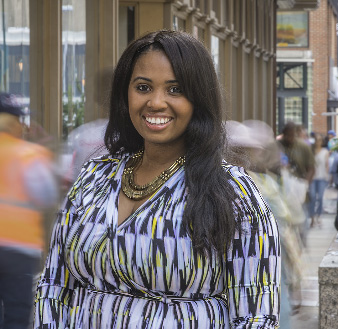Destination Excellence: Cultural Sensitivity
Communities as a whole, including our Drexel family, could benefit from talking about cultural sensitivity. As residents, we work in diverse, inner city and suburban populations. We need to have these conversations and not shy from talking about bias, racism and cultural sensitivity. We need to see the patient as a whole when we evaluate and treat them.

Mikal Hicks-Black, DO (in a photo from last summer) received the Educational Outreach Program award of the American Academy of Child & Adolescent Psychiatry to attend the organization's annual meeting and conference this past fall in Washington, D.C.
During my second year, a psychiatry fellow invited me to work on what would become a cultural compe-tence symposium for psychiatry residents. We discuss cultural sensitivity in class, but he saw a need to take the conversation further. As residents and then clinicians, we need to be especially mindful of the diverse cultures we continually encounter. After the first symposium, I recognized that we needed to keep the conversation going, and that prompted the next Cultural Symposium, which was open to attending physicians, nurses and social workers, as well as psychiatry residents and fellows.
The symposium speakers discussed mental health topics in relation to Middle Eastern countries, Asian populations and Russian culture, and the family in the clinical setting. For example, in Russia, there is a massive stigma about mental health problems. We need to be mindful that a patient from that culture may withhold information. The family says, "This is what's going on. We'll talk it out among ourselves." That insight was helpful. In another culture, individuals may value the advice of a spiritual adviser over that of a psychiatrist. As a professional, how does one reconcile that without alienating the patient?
Somatization
We discussed somatization — for instance, the patient presents with gastrointestinal complaints instead of saying "I'm anxious." We also introduced the idea of culture-bound syndromes, a disorder specific to a particular culture that does not appear to have bio-chemical origin or other objective signs. "Evil eye" is an example.
For many people, it is taboo to say, "I have a psychiatrist. I have a therapist." You know that's already a hurdle to people seeking care. When they finally do come to us, there's going to be an individual and family cultural component. Many times, their family comes with the patient to the ER. The family as a whole is trying to say, "Is this normal stress, or is it something that needs to have medical intervention or medication?"
Individuals may value the advice of a spiritual adviser over that of a psychiatrist.
When you introduce the concept of needing antipsychotics to someone — whatever their back-ground — that can be challenging. In the clinical setting, we're getting a better grasp on this. One of the symposium's goals was to introduce different ways people experience their mental health. When I started as a first-year, I may have thought, "This is the medication. This will help resolve your anxiety." But now, I try to familiarize myself with the other person's culture. Not everyone coming to us will be comfortable swallowing a little white pill that acts on their brain.
Within a culture itself, many times people seek guidance from a spiritual adviser or from a group that feels more comfortable to them than the medical community. When that happens, my thinking is, "This is what we, as professionals, have available. This other guidance sounds important to you, something that gives you peace and reassurance. So teach me a little bit about that." Then, as a clinician, I continue to do my research on their illness. What I'm finding is these conversations give us the language and the tools to better serve the patient. How do we approach someone about medication? How do we explain with lay terminology versus medical jargon?
Examining Preconceptions
Another goal of the Cultural Symposium was to stimulate internal reflection. What biases or misconcep-tions do we carry with us? We find ourselves in different settings: Hahnemann, Friends Hospital, Abington. In each of those settings, we have to be mindful of how we perceive the patient population. It has a lot to do with culture. I'm an African-American woman. My experience sitting in front of an Asian woman — even though we're both women — is going to be different from hers. I need to acknowledge any preconceptions on my end. What are my assumptions or thoughts about this patient's behavior?
Sometimes, unfortunately, we may be quick to diagnose someone based on misconceptions. If we find ourselves making remarks or sharing frustrations about a certain patient or even a certain demographic, then we need to ask, What about that patient or that culture makes me uncomfortable?
The more we're able to have open conversations and see the different backgrounds people bring to the table, the more we grow as clinicians. I feel this has made me a better physician and certainly a better psychiatrist and mental health worker. No one patient fits the DSM-V.
— Mikal Hicks-Black, DO, General Adult Psychiatry Residency ‘17, Fellow, Child & Adolescent Psychiatry
Back to Top